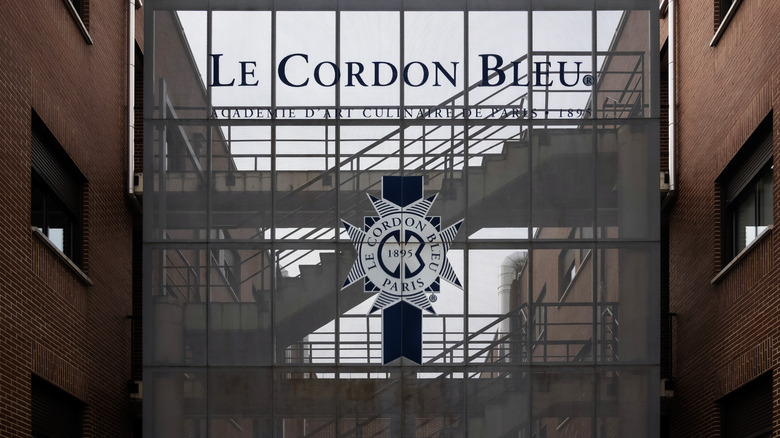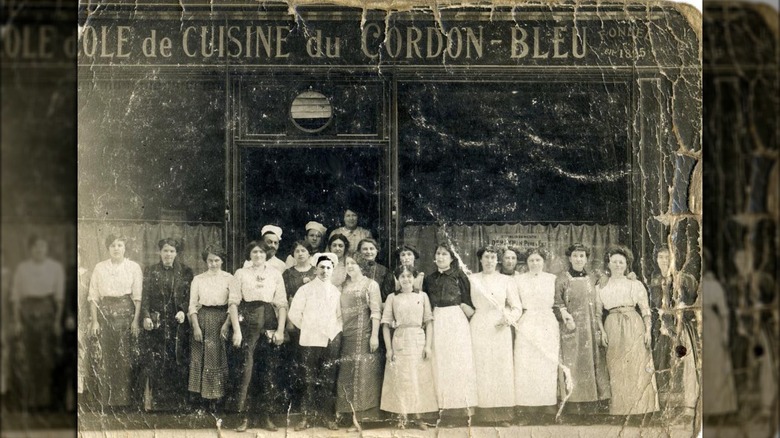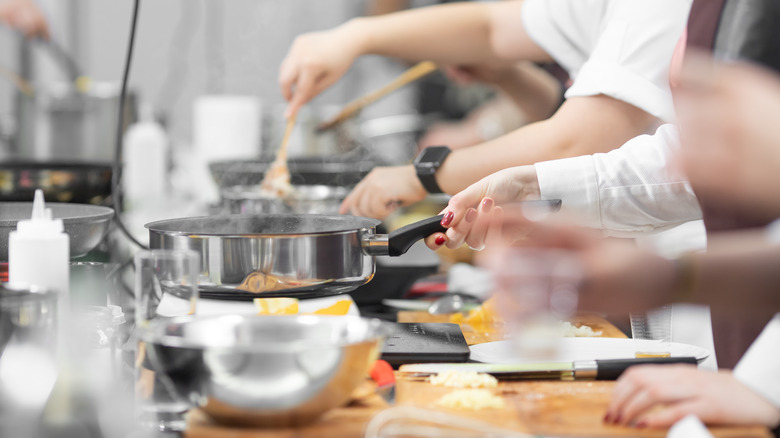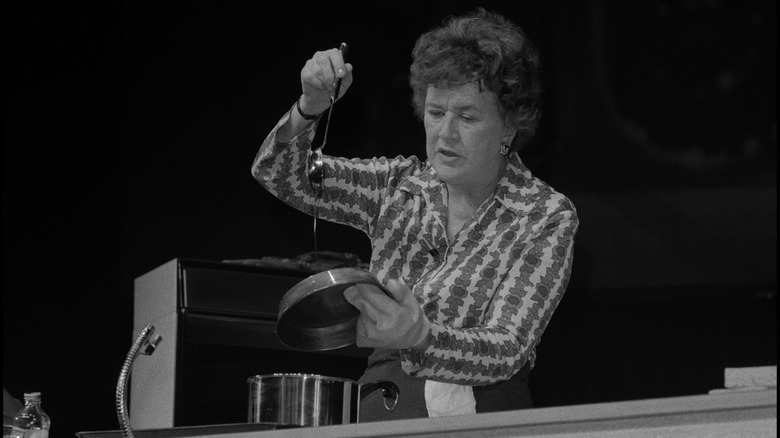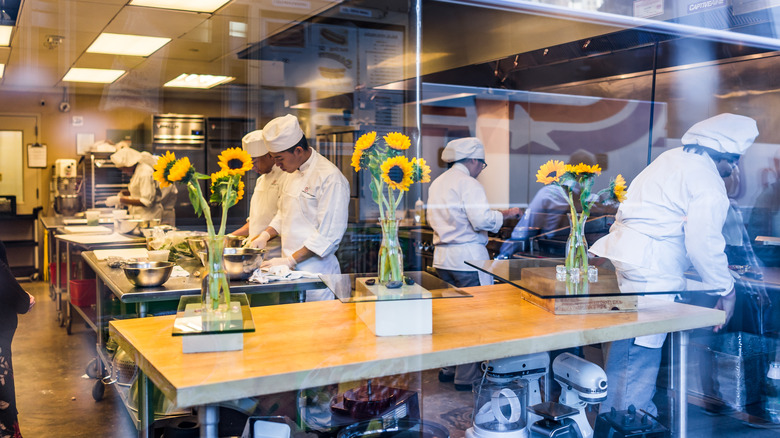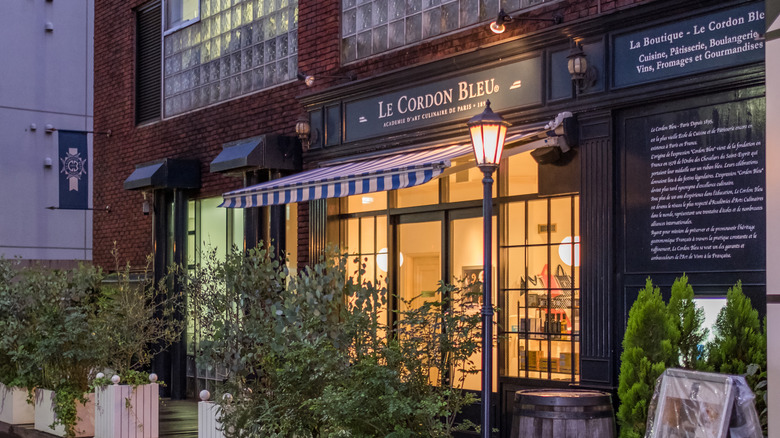The Untold Truth Of Le Cordon Bleu
Have you ever heard of Le Cordon Bleu? This storied Parisian cooking school is perhaps most associated with French cooking icon Julia Child, who graduated from the institution in 1950, Smithsonian says. Other cooking stars who stirred and sauced their way through a Cordon Bleu education include cookbook author Yotam Ottolenghi, television host Ming Tsai, and Peruvian chef Gastón Acurio (via Le Cordon Bleu).
Founded in 1895, Le Cordon Bleu was one of the first modern cooking schools, as well as the first to have classes taught by renowned French chefs and — wonder of all wonders! — electricity installed in its kitchens, ibiblio reports. Over the following centuries, the school expanded and now boasts more than 35 campuses in 20 countries around the world, according to its website. Positioning itself as "the guardian of French culinary technique," the school has maintained its prestigious reputation for more than 125 years.
Le Cordon Bleu was founded by a pioneering woman
In late 19th century France, professional cooking was pretty much a man's game, and fine dining establishments were almost exclusively headed by male chefs. Famously, about a century earlier, King Louis XV remarked to his mistress Madame du Barry that only men could become accomplished chefs, reports Food Travelist. So, Le Cordon Bleu was groundbreaking from its very first moments — simply because it was founded by a woman, Marthe Distel.
Distel was a French journalist working in Paris in the 1890s. A lover of fine food, she founded the publication "La Cuisinière Cordon Bleu" ("The Cordon Bleu Cook"), named after a then classic French cookbook published in 1827 entitled "Le Cordon Bleu ou Nouvelle Cuisinière Bourgeoise" (via Le Cordon Bleu). Distel's cooking magazine became so popular that the journalist decided to expand her project, making free cooking classes available to her subscribers. She released the announcement in an 1895 issue, adding that the recipes taught in the classes would be published in subsequent copies of the magazine.
Le Cordon Bleu was a quick success
And so, Le Cordon Bleu cooking school was born. On October 15, 1895, the first cooking class was taught by one of the most prominent chefs in Paris, Charles Driessens (via Le Cordon Bleu). Additional instructors included Henri-Paul Pellaprat, F. Barthélémy, Charles Poulain, and Auguste Colombié, all extremely well-known chefs at that time. Initially, Le Cordon Bleu's courses focused on "la cuisine pratique," or everyday cooking. But as its offerings expanded, the school also offered instruction in the fancier "haute cuisine classique," reflective of the elegant, refined types of dishes served in fine dining restaurants, according to ibiblio.
Locally successful from the start, Le Cordon Bleu soon began to attract international attention. In 1897, the school's first Russian student enrolled, followed in 1905 by the first Japanese student, the website says. A 1927 London Daily Mail article on the school noted, "It's not unusual for as many as eight different nationalities to be represented in the classes," per Le Cordon Bleu New Zealand.
1949: Julia Child's Le Cordon Bleu education begins
Most fans of French cooking know that Julia Child, the eccentric American cook who went on to become the United States' foremost expert on French cuisine, received her culinary training at Le Cordon Bleu and is undoubtedly the school's most famous alumna. According to the Smithsonian, Child enrolled in the school's 10-month program in 1949, her tuition fully paid by the U.S. government since she had worked in the Office of Strategic Services during World War II. Child was the only woman in her class but proved that she could keep up with the best students, completing her studies the following year in 1950.
Shortly thereafter, Child began working on her seminal cookbook, "Mastering the Art of French Cooking," along with two French colleagues: Simone Beck and Louisette Bertholle (via Le Cordon Bleu). The book would go on to revolutionize home cooking, presenting French recipes to an American audience with clear instructions and plenty of illustrations.
What is taught at Le Cordon Bleu?
With its founding in 1895, Le Cordon Bleu established the very notion of a culinary school. It was the first place where chef-instructors provided demonstrations of recipes and cooking techniques, allowing students to taste the dishes before preparing them themselves following their teachers' instructions (via ibiblio). To this day, the school's students benefit from top-of-the-line accommodations: Each has their own work surface, decked out with refrigerated marble for working with pastry and chocolate, as well as a professional-grade oven and an impressive range of kitchen utensils.
While some cooking schools are best known for either their culinary or pastry programs, Le Cordon Bleu is highly regarded in both of these areas. Its most comprehensive degree, the Grand Diplôme, combines the Diplôme de Cuisine with the Diplôme de Pâtisserie, providing a well-rounded education in both savory and sweet aspects of French cooking, according to Le Cordon Bleu. Along with its longer-term professional programs, the school also offers a variety of shorter courses for amateur cooks, including classes in specialty breads, wine and spirits, and nutrition.
The global influence of Le Cordon Bleu
Le Cordon Bleu may have Parisian roots, but it has nevertheless become a truly global brand. Today, the school counts 35 campuses in 20 countries, attended by 20,000 students annually, says the school's website. These include locations in London, Madrid, Istanbul, Rio de Janeiro, Mexico City, Seoul, Shanghai, Beirut, and more. Surprisingly, the institution had to close all of its U.S. locations in 2016 after federal government changes to financial aid affected the cost of running the schools (via First We Feast).
Nevertheless, the Cordon Bleu name continues to be widely known among Americans, in part because of its famous alumni — like Giada De Laurentiis, who completed a culinary degree at the campus in Paris and has been vocal about her "brutal" time there. "The chefs threw pans and rolling pins, I had burns all up and down my arms, and it was intense, laborious work," she told Total Food Service. "The experience absolutely threw away any notion that this would be easy. ... Going to Cordon Bleu taught me how to prove myself by not just talking the talk –- but walking the walk."
